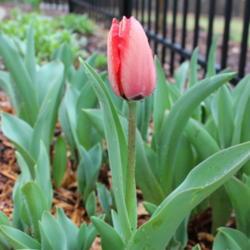
Follow these steps to prevent problems in your bulb patch.
The table below lists seven of the most common problems associated with crocus, daffodil, hyacinth, and tulip bulbs, see text below for recommended solutions.
| Problem | Bulbs affected | Possible cause |
| Buds, leaves, blossoms eaten | Crocus, tulip | Deer, squirrels, rabbits, chipmunks |
| Bulbs are being dug up | Crocus, daffodil, hyacinth, tulip | Squirrels, chipmunks, skunks |
| Bulbs seem to disappear from the ground | Crocus, tulip | Mice, voles, gophers, chipmunks |
| Growth starts even though cold winter weather is still expected | Crocus, daffodil, hyacinth, tulip | Unseasonably warm weather |
| Leaves appear, but plants don't bloom | Crocus, daffodil, hyacinth, tulip | Not enough chilling; leaves removed too soon the previous year; poor soil fertility; not enough sun; some tulips are short-lived |
| Blossom stalks are short | Daffodil, hyacinth, tulip | Not enough chilling; unseasonably warm winter and spring temperatures |
| Over the years, fewer plants and blossoms appear | Crocus, daffodil, hyacinth, tulip | Decline due to overcrowding, poor soil fertility, increasing shade |
Bulbs, leaves, blossoms eaten. Plant daffodils instead; they are unpalatable to animals. To deter smaller animals, use commercial or homemade repellents or scare tactics (dog or cat hair spread around bulb bed; hot pepper spray, flash tape or aluminum pie tins on twine, plastic scare owls or hawks). If deer are the problem, try a commercial deer repellent, or grow bulbs under protective netting supported by metal hoops or a wooden frame.
Bulbs are being dug up. Squirrels and chipmunks love to feast on crocus and tulip bulbs. Skunks dig in search of insects and worms but may also be attracted to organic fertilizers such as bone-, fish, or peanut meal. After planting, place hardware cloth, chicken wire, or other protective barrier over soil, and secure it in place. If skunks, cats, and dogs are troublesome, use well-decomposed organic amendments when planting.
Bulbs seem to disappear from the ground. If animals are the culprit, plant daffodils, which animals find inedible. To prevent pest animals from damaging bulbs, plant in an underground chicken wire cage. You can fashion your own, or purchase them ready made. Dry soil hinders root growth, causing bulbs to die and decompose instead of growing. Water well after planting, and roots should begin growing.
Growth starts even though cold winter weather is still expected. If bulbs haven't blossomed, they should weather the winter fine. Any blossoms and buds that emerge may suffer cold damage. Next fall, mulch the bulb bed just after the ground freezes in cool climates, and as temperatures reach winter time levels in warm climates.
Leaves appear, but plants don't bloom. In warm climates, choose varieties with low chilling requirements, and chill bulbs before planting. Allow leaves to remain in place until they fade completely. To hide fading foliage, plant companion annuals. If you aren't sure of a variety's longevity, ask the supplier before buying.
To improve soil fertility, fertilize at planting time. Each year in spring when plants are growing, spread an inch of compost, or feed with a low-nitrogen bulb fertilizer according to package directions. Bulbs need at least half a day of sun while the leaves are green (however, in warmest climates, afternoon shade is recommended).
Blossom stalks are short. Plant bulbs in the coolest area of your garden. In cool climates, mulch after ground freezes. In warm climates, plant low-chill varieties and mulch when winter temperatures are reached.
TipsIf bulbs have become crowded and are competing, dig and divide them. Reduce competition from surrounding plants by weeding and mowing regularly.
To increase soil fertility, in spring when plants are growing, spread an inch of compost or feed with a low-nitrogen bulb fertilizer according to package directions.
If shade has increased, thin tree branches or surrounding plants to allow at least half a day of sun in spring while the bulb leaves are green (in warmest climates, afternoon shade is recommended).